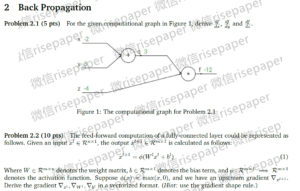
扫一扫又不会怀孕,扫一扫,作业无烦恼。
留学顾问の QQ:2128789860
留学顾问の微信:risepaper
MobileNets例题
Please provide a quantitative analysis on how the depthwise separable convolution
can reduce the amount of parameters and computations.
The computation bottleneck of MobileNets [2, 3] is the 11 convolution. In MobileNetV2 paper [3], 1 1 convolution even takes about 95% of the computation time. Please provide an intuition of how to address this computation bottleneck without affecting the performance. Explanation is needed to support your intuition.
CNN architectures方面学习了
AlexNet
VGG
GoogLeNet(Inception)
ResNet
DenseNet
What can we learn from LeNet-5?
Three types of fundamental layers: Convolutional layers, Pooling layers and fully-connected layers.
• Convolutional layers are responsible for extracting spatial features and computing output of neurons that are connected to local regions in the input.
• Pooling layers will perform a down-sampling operation along the spatial dimensions.
• Fully connected layers are responsible to produce the classification results.
References
[1] K. He, X. Zhang, S. Ren, and J. Sun, “Deep residual learning for image recognition代写,” in Proceedings of the IEEE conference on computer vision and pattern recognition, pp. 770–778, 2016.
[2] A. G. Howard, M. Zhu, B. Chen, D. Kalenichenko, W. Wang, T. Weyand, M. Andreetto, and H. Adam,
“Mobilenets: Efficient convolutional neural networks for mobile vision applications,” arXiv preprint
arXiv:1704.04861, 2017.
[3] M. Sandler, A. Howard, M. Zhu, A. Zhmoginov, and L.-C. Chen, “Mobilenetv2: Inverted residuals and
linear bottlenecks,” in Proceedings of the IEEE Conference on Computer Vision and Pattern Recognition,
pp. 4510–4520, 2018.
